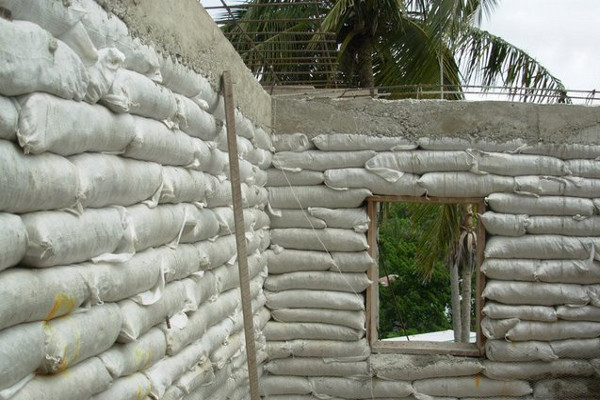
“Earthbag building fills a unique niche in the quest for sustainable architecture. The bags can be filled with local, natural materials, which lowers the embodied energy commonly associated with the manufacture and transportation of building materials.” – Kelly Hart
What is earthbag building?
According to some estimates, one-third of the world’s population is housed in earth buildings. Building in earth has a very long history, and has been practised in regions as diverse as Asia, Europe, Africa, the Americas, and in modern times Australia. The adobe buildings of the Southwestern United States are well known, as are the astonishing earth buildings, indeed earth cities, of Africa. Across Europe, earth has long been used in construction, either as infill, daub, or to build earthen walls like cob, or witchert in places like Buckinghamshire. Earthbag building then, is a modern twist on perhaps humanity’s most important building tradition.
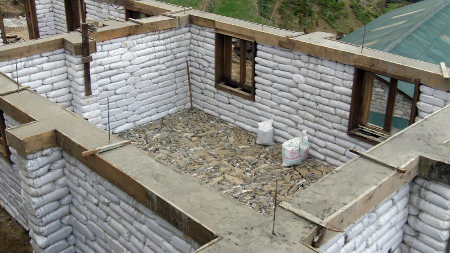
Bags or tubes are filled with earth (a suitable aggregate, sometimes with additions, and if you’re really lucky it’ll just be the stuff you moved to make the site for your building), and then placed in walls; barbed wire is used as a tie or ‘mortar’, and the bags are ‘rammed’. Most often then, the earth cures, and makes solid walls which no longer rely on the bags or tubes for their integrity.
From its origins in the building of military bunkers, and in flood defence, earthbag has been developed and applied around the world. It has been widely tested both structurally and thermally.
The history of earthbag building is covered in detail in a very readable article by Kelly Hart.
What are the benefits of earthbag building?
One of the reasons why earthbags were so widely used for military purposes and for flood defence is that the materials are easily transportable and easy to assemble. The advantages of the technique however are much more extensive than this. Kelly Hart’s colleague, Dr Owen Geiger put it this way:
‘Earthbag is extremely versatile and strong, and also very low-cost and simple. It’s ideal for harsh climates and regions with hurricanes and earthquakes. A large portion of humanity lives in hazardous areas like this and so earthbag building has enormous potential. Just look at Nepal for instance. All of the 50-some earthbag buildings survived the recent earthquakes with little or no damage even though they were not built to the highest standards.’

Cost-effective and community-empowering, earthbag buildings share their ‘feel’ with earth structures of other, older styles. Dr Geiger again:
‘The final homes feel wonderful – very safe and secure. You could literally drive a speeding truck into the side of these structures and cause only minor damage such as chipped plaster. Right now in Nepal, people want to stay in the earthbag buildings because they’re fearful of their concrete and brick houses. In hot climates like where I live, they stay cool and comfortable 24 hours a day every day of the year with appropriate design.’
We asked Dr Geiger about the durability of earthbag structures, and about any limitations he could see in the technique:
‘Earthbags evolved from use in the military and flood control. They are bomb, bullet and flood resistant if built correctly and therefore should have a very long lifespan. Just keep in mind that buildings made of earth and other high mass materials such as stone are not the best choice in cold climates. You could add exterior insulation, of course, but straw-bale seems like the best solution for Canada, northern US, etc.’
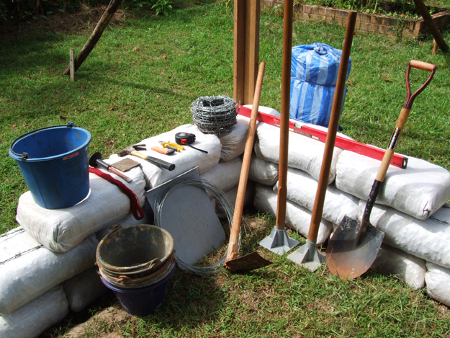
One of the most noticeable things about straw-bale building for example, and the same is true of cob, is that the relative simplicity of the method makes builders of people who have never thought of themselves as such. Dr Geiger puts it this way:
‘Each step can be demonstrated in a few seconds as you can see on my free YouTube videos. https://www.youtube.com/user/naturalhouses. I’ve taught housewives, 75-year-olds, teenagers, you name it – even those who speak no English. It boils down to filling buckets with moist soil, dumping it in bags and tamping them solid. It’s super simple. The only difficult part is standard carpentry. Every home needs doors, windows, etc. and that’s where it’s helpful to check out a carpentry book from the library with lots of good drawings.’
What can I do?
Wherever you have a suitable material to fill bags, you can build. Originally, for military bunkers and flood defence, burlap sacks were used, but modern earthbag builders mostly use woven polypropylene bags. The world is full of polypropylene bags, such an over-supply almost demands a use in construction. Tubes are also commonly employed, in a practice known as superadobe; and a material called Raschel mesh (which can be UV-protected) is sometimes used for the tubing – this is called hyperadobe!
Dr Geiger had this to say on the matter:
‘Polypropylene bags and tubes are by far the most common material. Raschel mesh is gaining in popularity (hyperadobe). Poly bags are extremely strong and, according to the US Dept. of Transportation, will last at least 500 years if kept out of sunlight. That’s the main weakness – poly bags and Raschel mesh bags break down in UV, so we always emphasize the importance of protecting the bags until the walls are plastered.’
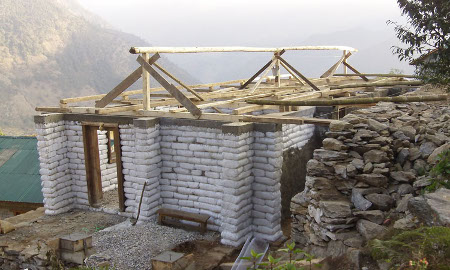
As for the material to fill the sacks, if the earth is going to provide the strength in the wall system as it cures, then earthbag builders need a soil that is approximately 30% clay and 70% sand. This is the standard soil for rammed earth building, what Hunter and Kiffmeyer call ‘the Ultimate Clay/Sand Ratio’. Earthbag can be used where clay is not present in these quantities by importing materials to the site, or by relying more on the integrity of the bags or tubes in the design. Under these circumstances, earthbag infill systems can also be considered, that is to say, much like straw bales, earthbag can be combined with a timber frame of some sort.
Dr Geiger pointed out that earthbag is not necessarily the best material in cold climates like Canada for example, and that straw-bale has advantages where super insulation is required. Nonetheless, earthbags can be made more insulating through the addition of materials like rice hulls, or hemp perhaps, and earth-sheltering can make earthbag building feasible even in regions with very cold winters. Hunter and Kiffmeyer remind us that ‘the earth itself is nature’s most reliable temperature regulator’.
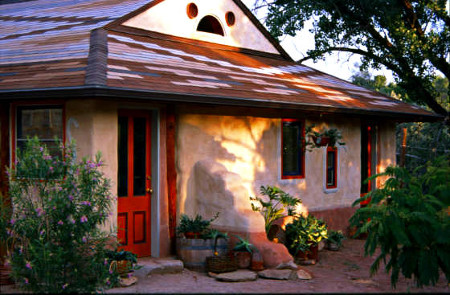
Earthbag structures can be finished in a range of ways, but cement is often used on the exteriors, with earth plasters on the interior. This is what Dr Geiger had to say about the use of cement (not the ecological builder’s ideal material):
‘Most people use cement plaster because that’s what’s most available. For instance, lime is not available where I live. I’d have to buy a whole truckload from 600 miles away. And local plasterers don’t know how to use it. Plus, cement plaster is harder and will withstand hard driving rains.’
Lime plasters can also be used of course, applied by hand, trowel, or spray gun, and certainly would not bring the recognised environmental impacts of cement, including its contribution to CO2 emissions worldwide.

Polypropylene is susceptible to UV damage, so walls should be protected from exposure to the sun before they are rendered (builders’ sheets hung over or down the walls would do the job). As noted above, Raschel mesh can be UV-protected. Old fashioned burlap sacks are not UV sensitive, but they do wick moisture, so whilst it would be possible to build with burlap, such buildings would no doubt need the ‘good hat and stout pair of boots’ demanded of cob or straw-bale structures.
Earthbag building has given rise to a distinctive dome style of construction, with arched windows and doors, and very many round buildings. This aesthetic has arisen because earthbag building, particularly superadobe, is well suited to such expression, but it’s not at all obligatory. Earthbag buildings can be any shape, and earthbag techniques are as versatile as any earth or bale building.

In any region with a vernacular earth building tradition, earthbag building would seem to be worth considering for self-build projects. Even in areas where the earth is not suitable, other materials might be usable after experimentation. As with all self-builds, you will need to be aware of the planning implications of what you want to do where you want to do it, and if you’re building something large enough, you may very well encounter an as yet undefined area of building regulations.
Earthbag is highly cost-effective and technically accessible, and is being used in at least one of the dwellings at Lammas Eco-village in Pembrokeshire, so it is already being pioneered in this country. The required toolkit is very simple. You can make your own tampers (a stick with a lump of concrete set on the end, or a log with a handle put into a hole drilled in it!); you’ll need a shovel, and something to cut the barbed wire with.
A quick search online will find suppliers of woven polypropylene bags, but it’s worth shopping around because even a difference of a few pence per sack could change the economics of your whole project. There are also UK manufacturers and suppliers of Raschel Mesh.
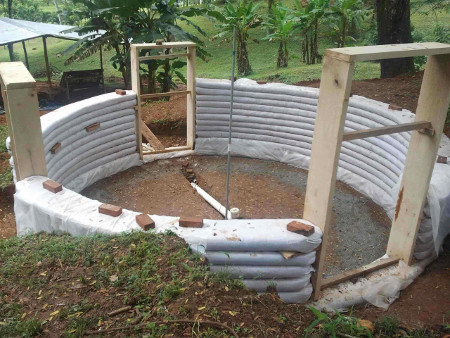
For self-build homes, community and ancillary buildings, earthbag offers an interesting and adaptable alternative. Whether it’s right for your site, or for your needs may well depend upon the present cost of small bales, because bale building would seem to be the most obvious competitor to earthbag for the attention of eco-builders.
Earthbag building in the UK is in its infancy. Whilst we have quite a number of earth builders, earthbag doesn’t seem high on their list of priorities. This means that if you’re interested enough to give it a go, you’ll be right at the cutting edge.
Thanks to Dr. Owen Geiger of Earthbagbuilding.com for information and images
Whilst you’re here, why not take a look at the other 30+ shelter topics available? And don’t forget to visit our main topics page to explore over 200 aspects of low-impact living and our homepage to learn more about why we do what we do.
The specialist(s) below will respond to queries on this topic. Please comment in the box at the bottom of the page.

Paulina Wojciechowska is a qualified architect who studied earth building at CAL-Earth in California, and has built and taught using earth bags all over the world. She is the author of Building with Earth, and she taught Technology and Development at Oxford Brookes University. She runs earth-building company Earth, Hands & Houses.
The views expressed here are those of the author and not necessarily lowimpact.org's
28 Comments
-
1Alexis October 20th, 2016
Hello !
My name is Alexis and my wife and I are launching a crowdfunding campaign in order to help us to build our own eco house in South France.
The structure would be made using the Hyperadobe technique. The building (50 m2) is gonna be as green as possible in terms of constrcuction.
Soil for the walls, pallet wood flooring and green roof on top of that !
We want to create a little self sufficient paradise by adding a biogas mini plant, solar panels or Wind turbine for energy management but also use as less as possible water by using dry toilet and Rainwater harvesting devices.
You can see more détails on our crowdfunding page :
https://www.justgiving.com/crowdfunding/ourearthbagecohouseproject
Best regards
Alexis
-
2Adam Polak June 25th, 2018
Hi Alexis,
Do You want to build a house from “Earth Bags”?
Do You know where to purchase “Earth Bags” within Europe?
We are building similar project to Yours in Portugal, but we do not want to buy “Earth Bags” from US.
Many Thanks,
Adam
-
3Chris Gander June 28th, 2018
Mylittlehomestead is a fantastic weekly YouTube presentation involving earth bags. Go watch it and also marvel at family living in the 21st century. There’s lots of other snippets on the website that are just great.
-
4Paulina Wojciechowska July 13th, 2018
Hi Adam, We often use this company for sourcing earthbags – weirbags.co.uk / https://www.weirbags.co.uk/buy-online/fabrics-cloth-film/woven-polypropylene-fabric. But if you Google ‘Woven polypropylene tubing’ You might find other companies too.
Good luck, Best wishes, Paulina
-
5Anthony September 23rd, 2018
We are based in Morocco and are looking to build 5 x 6m diameter towers for an eco project. The towers will be a conicle shape cylinder of about 4m high with a flat roof ceiling diameter of 5m. We would like to put a timber viewing platform on top.
There is not much advice available her in Morocco and being English I thought i would see what advice I can get back in the UK.
This is not a well understood method of construction here so I will have to prove the structural integrity to the local building control officer….. difficult.
Can you help or recommend somebody that can?
-
6simon April 5th, 2019
Hello my name is simon a Kenyan based in London . Love the idea here . I am considering relocating to build the same in Kenya on a farm . I now have an acre and would love to invite volunteers to come help me with the technical how . In return I will provide food and shelter in a good hotel local to me . I will also throw in a safari tour to Tsavo park for a day . I am happy to discuss time – email me [email protected]
-
7Bria muller January 11th, 2020
Good day, please can you tell me where to buy earth bags in the UK.
Warm regards
-
8Dave Darby January 13th, 2020
Bria – see comment no. 4, above.
-
9Steve C August 12th, 2020
Hi Paulina – I need to build a retaining wall 2m high and I thought I might try using earthbags. Do you have any tips? All the information I have seen relates to houses.
-
10Dennis Bosco Demello October 26th, 2020
Hi Mam, I am from India, West Bengal, I am looking for a low cost way to build a one storey (G+1) building in 500 sq ft using Earth Bag, is it possible to build it.
Please guide
-
11HEnk May 26th, 2021
Hi, thanks for the information! We like to build 4 small recreation houses, 25m2 each. We like to south side with glasses and the other sides like a hill with grass.
We live in the Netherlands, cold and humidity are problems.
Are there tips how we get the hunidity out, some damp folie? And tip what between the wall and the ground we want to put against it?we think about hyperadobe system and and the ground we want to use is 70-80 % clay, would that be a problem.?
Thanks warm regards Henk
-
12Paulina Wojciechowska June 9th, 2021
Hi HEnk
Using the earthbag superadobe wall building system would be ok even with earth of high clay content as long as you can keep the walls dry or cement stabilised. If clay gets wet it usually expands and if it gets wet and freezes it will expand further so you will need to really keep the water away if you can.
If you are building into a slope you will first need a retaining wall with very good drainage as well as the wall of your house on the inside of the retaining wall.
You will also need a rigid moisture barrier like you might use in cellars and underground buildings and swimming pools.
The retaining wall would be against the waterproofing and then it would be good to have a 30cm minimum gap between the retaining wall and the house wall filled with gravel with good drainage incase any moisture gets through.
There should also be a moisture barrier under the floor to really protect you from the damp Dutch weather.
You will also need good thermal insulation in the floor and the back wall to keep the heat in and the cold out.
We have used a 25 to 35cm think strawclay plaster on the inside of earthbag walls as natural insulation but this is very labour intensive work. There are many insulation materials you can research.
Good luck with your build.
Best wishes
Paulina
-
13Paulina Wojciechowska June 9th, 2021
Hi Dennis Bosco,
I’m sorry I didn’t see your question earlier.
Yes you can definitely build a single storey building out of the earthbag technology without cement, just soil with a little clay content like rammed earth.
You will need buttresses by all the openings and a cement stabilised beam at the ground level and wallplate cement stabilised beam at the top of the wall so that the roof structure can be tied to this beam. This wallplate beam also needs to be tied to the wall with anchor bolts and straps.
Best wishes
Paulina
-
14Paulina Wojciechowska June 9th, 2021
Hi Steve C
Sorry for my very late response.
Building 2m high retaining walls using earthbags would be great.
My tip would be to use very wide bags 60cm wide minimum and curve the wall or if it’s straight use large strong buttresses.
You can also build a double wall for the first 1m in height then go with a single row and always remember to stagger the joints to make a stronger wall.
Best wishes
Paulina
-
15Jesse November 17th, 2022
Where is literature/videos for the earth bag construction?
-
16Rebecca Stacey November 17th, 2022
Hi Jess, you can find links on the site mentioned above here: https://earthbagbuilding.com/faqs.htm and plenty of other links and ideas in the article. If there is something specific you need help with just shout!
-
17Angus December 10th, 2022
Hi – may I use one of your photos to help me promote an online talk that is happening next week? This is the image I want to use, but I do not want to infringe copyright, so I am asking your permission,
If you would like to view the talk, then let me know and I can send you a link.
Thank you.
Angus
-
18Dave Darby December 13th, 2022
Angus – contact me via the contact page, with a link to the image you want to use (and of the talk).
Dave
-
19Dil Green January 2nd, 2023
I’m increasingly certain that we should be building as many new buildings as possible with local sub-soil – soil obtained from the building site itself, if possible. There are many, overlapping reasons why this improves on current building modes, and so I’m happy that this seems a popular topic.
One aspect not covered, that I would be glad to hear more about, is the idea of using the excavation needed to form a cellar to the house (or near to it).
Cellars are going to be very important, as the climate emergency intensifies, for many reasons. In many regions, we are already seeing intense temperature spikes (both highs and lows), lasting for days and weeks. Existing buildings, and the way we are used to living in them, are not designed for these extremes, and retrofitting whole homes is going to be both impractical (uneconomic) and counter-productive (as it consumes more resources and more energy).
Cellars and basements provide temperature stabilisation to a good degree, without need for energy – and are also robust in extreme winds. These novel uses are in addition to the well-known benefits such spaces provide in storing food in stable conditions which can increase the usability of locally grown food.
My question, then, is about experience in using soil excavation to provide basement / cellar spaces – what are the important considerations?
-
20Even Dawn February 17th, 2023
Hi Dil Green, I agree with you comment as I am also researching earthbags for cellar construction. I am concerned about the issue of moisture seeking into the cellar so we will have to leave a gap filled with gravel around it, and I am considering rendering with latex stabilised cement which should be waterproof.
What I am wondering is if I dig the cellar down to about a meter under ground level with most of it recessed into the side of a slope, whether the mass of the earthbag walls on the exposed side is enough to stabilise the cellar temperature.
-
21Paulina Wojciechowska March 27th, 2023
Hi Dil
The important considerations for the use of excavated soil are that the soil you re use is subsoil and not top soil and has some moisture content, meaning that when it's tamped it can become as solid as stone. It important that its not too wet as too much moisture will hinder the tamping process. When the earthbag fill is too wet the bags discolour when tamped and sometimes moisture seeps out.
The subsoil can contain some clay or can just be sand. What you don't want in the mix is topsoil or large stones.
Paulina -
22Paulina Wojciechowska March 27th, 2023
Hi Even
Yes, the mass of the earthbag wall is enough to stabilise the temperature if its dug in at one end, but the more the cellar is dug into the ground the more it takes on the temperature of the ground. If its not in the ground it will need a door with a good seal to keep the cool air in.
Paulina -
23Henk March 28th, 2023
Thanks!
Our project in the Netherlands is not yey started:(
I used ai to get more info about the building and addresses and questions.
For projects in Europe.
warm regards Henk -
24Bert Fegg October 30th, 2023
Hi I'm a freeloader. Will you give me some money for my pet project that will just benefit me?
-
25Dave Darby October 30th, 2023
Bert - good question. I mean if you don't ask, you don't get.
No, btw.
-
26Henk October 31st, 2023
Bert, I'm not familiar with the term 'freeloader,' but I understand from Google Translate that it refers to a kind of parasite. Can't parasites also burrow underground?"
-
27Bert Fegg October 31st, 2023
Ha! Yeah I'd love to make an earth sheltered house. I'm in Scotland and struggling to work out the best construction method. I have no money. Earthbags are cheap and I have the soil on site. But it's somewhat cold, very windy and wet. The ideal material is straw bale I think, but that means complications keeping the walls dry and frost-free and it's great for walls but not so much for roofs. Could do earthbags and put the insulation on the inside of the wall. But then breathability of the insulation isn't so good. I don't want any plastic on site really and would prefer to use hessian sacks if earthbagging, but then I'd have to add something as a binder. I have stone, earth and turf on site. No wood. So I'm thinking arches and domes for roofs. But that makes a water ingress problem. No good source of clay unfortunately.
-
28Henk October 31st, 2023
Hello Bert,
What would I do if I lived in beautiful Scotland?
I once spent a few nights in a tent in a very remote Loch and was completely covered in mosquitoes…
Months later I still didn't have the last of it :) But one of the most beautiful countries in the world! And nice people!
Is it an idea, for example, to stretch old tents that are often left behind at festivals and can be obtained for free over an earth bag house to keep it waterproof?
A ditch and a layer of pebbles for drainage? and perhaps a combination of soil and straw.
Good luck





 Low-impact building
Low-impact building
 Cob building
Cob building
 Planning permission
Planning permission
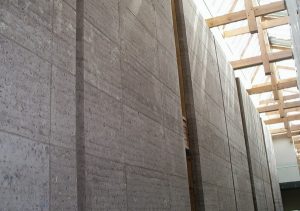 Rammed earth building
Rammed earth building


